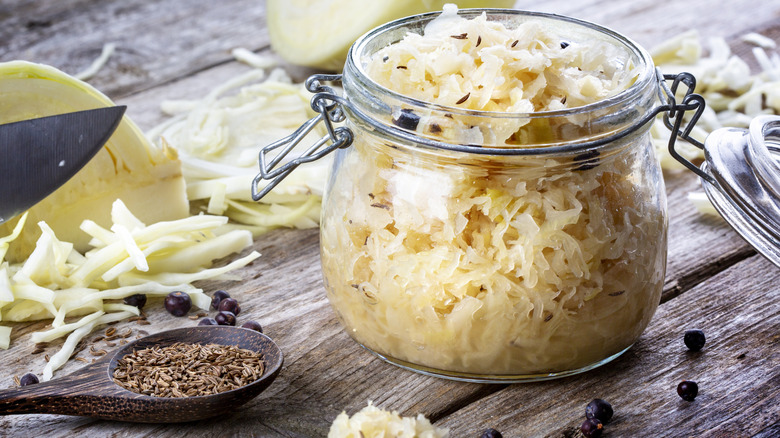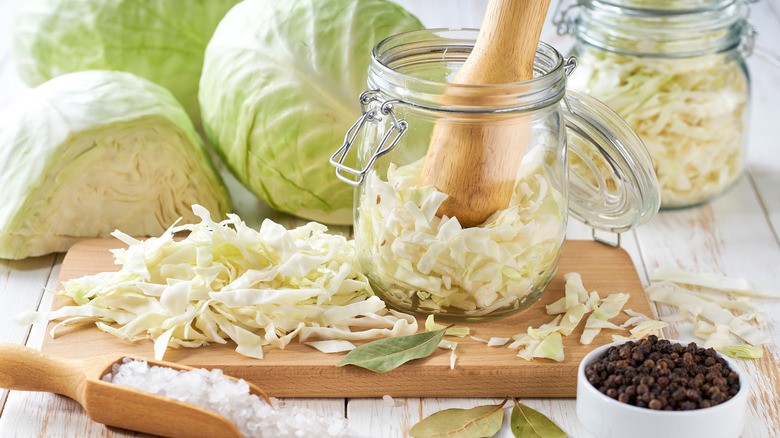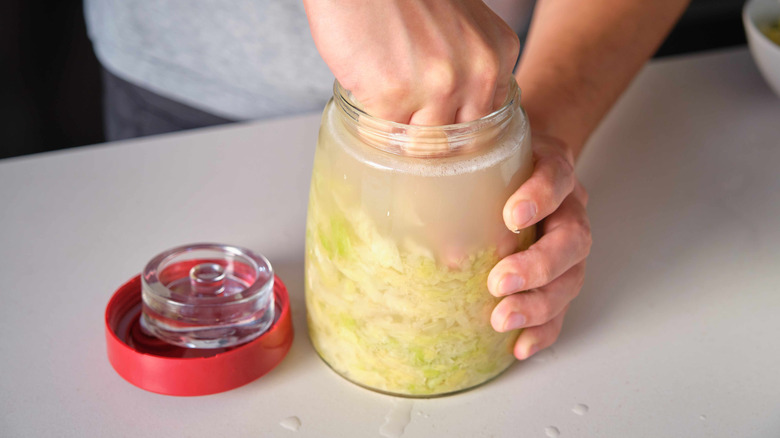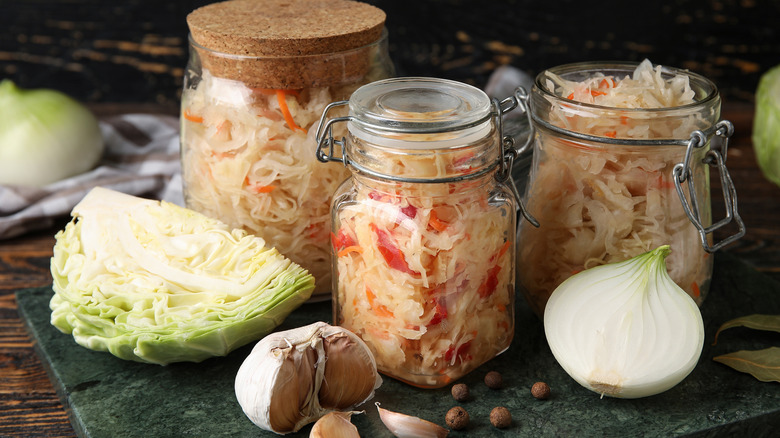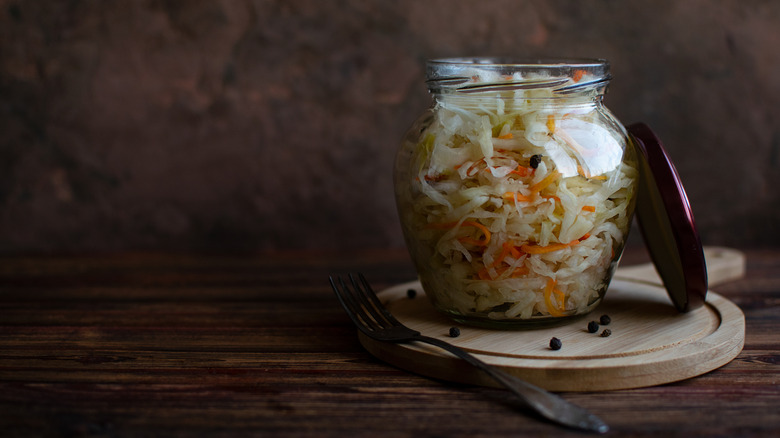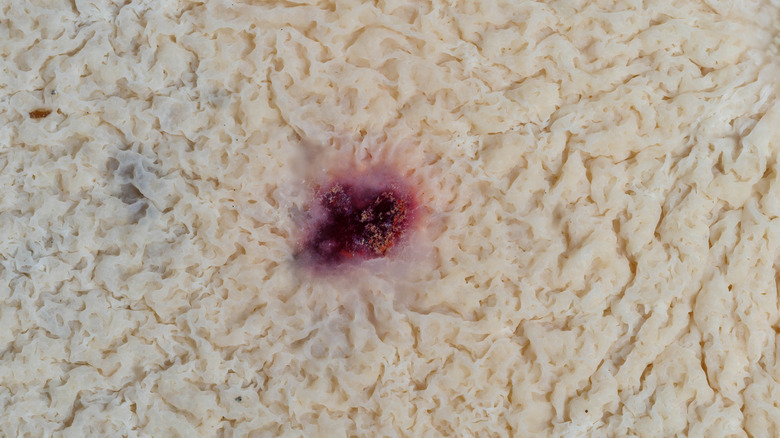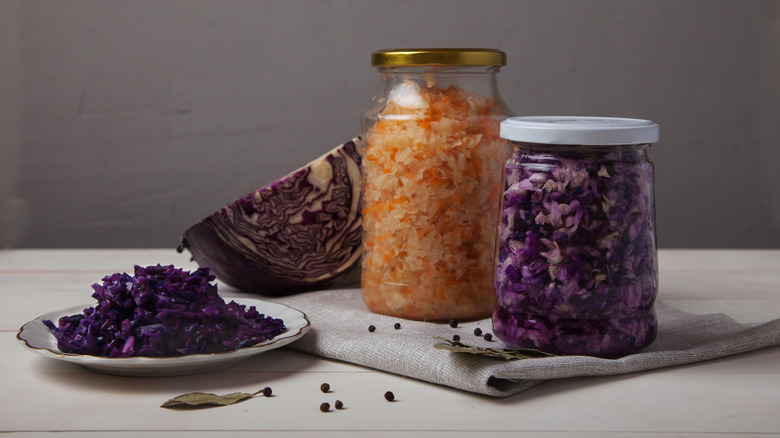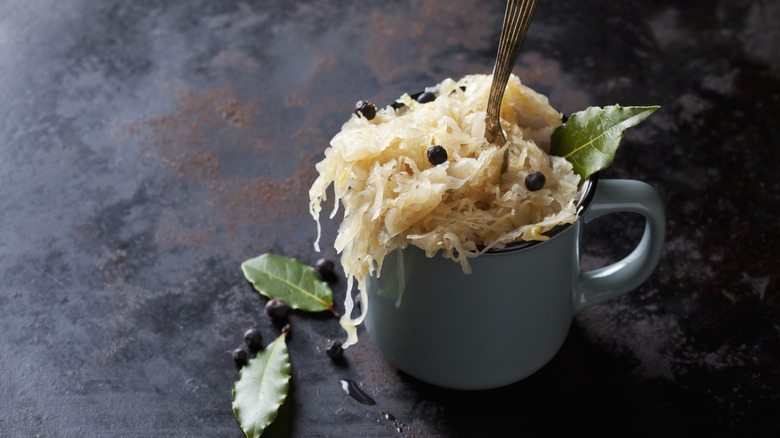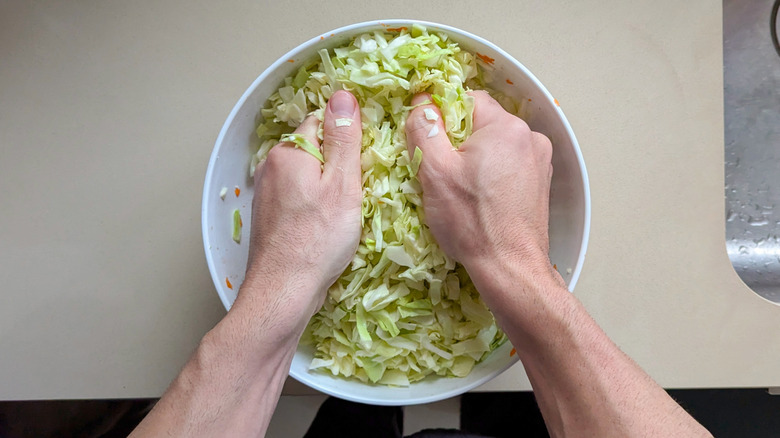Experts Reveal 10 Mistakes Everyone Makes With Sauerkraut
We may receive a commission on purchases made from links.
Making sauerkraut should be straightforward — after all, it's just cabbage and salt. Yet many beginners find themselves battling mold growth, mushy textures, and overly salty results that make them want throw in the towel and cry in a corner. Some might become paralyzed and overwhelmed by the fear of food safety, while others struggle with recipes that don't explain the reasoning behind each step.
But if this is you, you're missing out on one of the healthiest foods on the planet. Sauerkraut is packed with probiotics that support gut health, vitamin C levels that rival citrus fruits, and tons of vitamins and minerals. Eating fermented foods everyday can be one of the best things you can do for your body (you can even add them to pizza). The good news? These frustrating problems stem from a handful of easily avoidable mistakes. Once you understand the science behind successful fermentation, you'll be unstoppable, eating heaping bowls of gut friendly goodness and feeling amazing.
To guide you through these challenges, we've gathered insights from two fermentation experts. Kris Schlesser brings practical restaurant experience from LuckyBolt Kitchen + Bakery, a farm-to-table eatery in San Diego where consistent, high-quality fermentation is an essential part of the menu. Sandor Katz, renowned fermentation educator and author of "The Art of Fermentation," widely considered one of the definitive books on the subject, offers deep scientific understanding paired with encouraging, accessible teaching methods.
Not tasting the cabbage for salt
Sandor Katz has a different approach to the usual guidelines in recipes, "I recommend that people salt sauerkraut to taste, rather than relying on any generic proportion. Many recipes use a proportion of 2%, which is fine, but I find that to be a little saltier than I like."
Understanding why salt works helps explain why taste matters more than formulas. According to Katz, "Salt is not essential for safety; it helps keep vegetables crispy and slows the enzymes that can make them soft." Salt isn't acting as a preservative here, it's managing texture and fermentation speed. This means the "perfect" amount varies based on your preferences, and how long you plan to ferment.
Learning to salt by taste is straightforward. Start by shredding your cabbage and adding about 1 tablespoon of sea salt per 2 pounds. Mix thoroughly and let it sit for 15 minutes. Then, massage the mixture with your hands until liquid appears. Taste this extracted liquid, which represents your future brine. It should taste pleasantly salty, like mild seawater. If you are a complete beginner, you could make a brine on the side for reference, with 1 of cup water and 1¼ teaspoons of salt. Taste your brine and then the cabbage brine alternatively to see if they are similar. If it's too bland, add ½ teaspoon more salt, massage again, and taste. If it's too salty, add a tablespoon or 2 of purified water and remix.
Not submerging the cabbage
One of the most devastating mistakes new fermenters make is underestimating how crucial it is to keep their vegetables completely submerged. As Kris Schlesser explains, "The cabbage needs to stay completely submerged in the brine during fermentation in order to stay safe and mold-free." Lactic acid bacteria thrive in oxygen-free environments, creating the acidic conditions that preserve your vegetables. When oxygen enters the equation, you're creating the perfect environment for unwanted microorganisms that can ruin your entire batch. As Schlesser warns, "If you don't put weights on top of your sauerkraut to keep it submerged, then anything that touches the air will likely spoil and invite trouble."
Start by placing a large outer cabbage leaf over the top to keep small pieces from floating up, then add weights to keep everything below the waterline. Glass fermentation weights work beautifully, but don't feel pressured to buy special equipment. A plate that fits just inside your fermentation container, weighted down with 2 or 3 clean quart jars filled with water, works well. Another effective method involves using a large food-grade plastic bag filled with salt water (about 4½ tablespoons of salt in 3 quarts of water). Remember to leave about an inch of headspace in your jars. Finally Sandor Katz also advises, "If there is not enough brine to cover vegetables, it's okay to add a little water (dechlorinated)."
If you discover exposed vegetables, don't panic. Remove any discolored or fuzzy portions along with the surrounding inch of vegetables (like the red flag you would look for when shopping for produce), ensure everything remaining is properly submerged, and your fermentation can continue successfully.
Rushing the process
An often overlooked necessity for successfully making sauerkraut is patience. As Kris Schlesser observes, "People often rush the process. Fermentation takes time. Just because it looks done after a few days doesn't mean the flavors have fully developed." Let's take a look at what is actually happening with the fermentation to understand why patience is so important.
Sauerkraut fermentation unfolds in three distinct stages. During the first five days, salt-tolerant beneficial bacteria (L. mesenteroides) get to work breaking down sugars and producing those tell-tale bubbles while creating the oxygen-free environment needed for proper fermentation. From days five through 16, a different group of beneficial bacteria (L. plantarum) takes over, focusing their energy on producing lactic acid, which acts as a natural preservative. Lactic acid is also amazing at supporting digestive health and increasing vitamin availability. The final stage, from days 16 through 21, sees yet another type of beneficial bacteria (L. pentoaceticus) fine-tuning the acidity levels and developing the complex, nuanced flavors that make homemade sauerkraut so superior to store-bought versions. When the sugars are finally consumed, fermentation naturally ends.
This is why it is so important to give it time. At Lucky Bolt, Schlesser explains, "We typically ferment our kraut for at least two to three weeks, sometimes longer depending on the season. After the first few weeks of fermenting at room temperature, we refrigerate our fermentations where they can still develop more complexity. Patience rewards you with a deeper, more complex flavor that's well worth the wait."
Allowing the gas escape
Unlike ferments such as vinegar, kombucha, or sourdough starter that depend on airborne microbes and oxygen exposure, sauerkraut fermentation relies entirely on the natural sugars present in your cabbage. This self-contained process means you can successfully ferment vegetables in sealed containers, but there's an important caveat that many beginners overlook.
During active fermentation, beneficial bacteria consume sugars and produce carbon dioxide as a natural by-product. Those bubbles rising to the surface create pressure inside your container. As Kris Schlesser warns, "Avoid putting your sauerkraut in a container that doesn't allow the gas (carbon dioxide) to escape. All those bubbles that you're seeing are good, they let you know that the process is working. Just make sure that you don't trap all of those bubbles inside and allow pressure to build up. This can literally lead to an explosion."
Keep your fermenting jar on the kitchen counter where you'll see it daily. Check for pressure build-up by observing whether the lid appears to bulge upward, then release pressure by loosening the lid as needed. Alternatively, place the lid loosely on the jar from the start, allowing pressure to escape naturally.
For a more hands-off approach, consider investing in airlock lids. These specialized lids automatically release pressure while preventing mold spores and unwanted yeasts from entering your fermentation. With airlocks, you won't need to monitor pressure daily or worry about removing surface mold, making the process more fool proof for busy schedules.
You don't remove the kahm yeast
Surface growth on your fermenting sauerkraut is completely normal and shouldn't cause panic. What you're most likely seeing is kahm yeast, which appears as a beige-colored layer with a dramatic, wave-like texture. As Sandor Katz explains, "Kahm yeast growth is not a problem; skim it off as best you can and enjoy your kraut. It is inevitable, eventually, unless fermenting kraut is perfectly protected from oxygen."
While kahm yeast itself isn't harmful, neglecting to remove it can lead to actual mold development. As Katz explains, "Kahm yeast generally appears first, and if mold develops, it tells me you have neglected removing the Kahm yeast." Left too long, mold penetrates deeper into your vegetables, making them mushy and potentially moldy-tasting while also digesting the lactic acid that preserves your fermentation.
To remove it, first, carefully remove any weights from your fermentation. Using a wide stainless steel spoon, get underneath the growth and skim off as much as possible. Don't worry if you can't remove every bit, especially with white growth. According to Katz, "As long as the mold is monochromatic (a hairy white mold that develops patches of grey or black as it matures) I would just remove the mold and the top inch or so of kraut, or to whatever depth seems soft or discolored, and enjoy the lower layers." However, bright colored molds signal serious trouble. Katz warns, "I have never seen a bright colored mold on kraut, but if you get one, definitely discard the whole batch."
Using metallic lids
Fresh cabbage begins with a neutral pH between 5.2 and 6.8, but as lactic acid bacteria consume the natural sugars and produce lactic acid, your sauerkraut becomes increasingly acidic. The finished product reaches a pH of 4.6 or lower. This acidity creates the tangy flavor but unfortunately, it can also corrode metals. If left for too long, the harmful metals may to leach directly into your ferment. Because of this corrosion, Sandor Katz advises to use non-metallic lids if possible.
Food-grade plastic lids offer the most practical solution for home fermenters. They're widely recommended for both active fermentation and long-term storage because they don't react with acids and are easy to clean.
If you must use metal lids temporarily, create a barrier between your ferment and the lid using parchment paper or waxed paper. But we recommend investing in proper non-metal lids to ensure your fermentation stays safe and flavorful.
Not experimenting with different flavors
Another mistake beginners make is playing it too safe. As Sandor Katz encourages, "You can make beautiful and delicious sauerkraut from any variety of cabbage, or any vegetable for that matter. Mix vegetables, add fruit, seasonings, mushrooms, seaweed, or cooked vegetables, don't be afraid to experiment."
Traditional variations from around the world prove that creativity has always been central to fermentation. German sauerkraut incorporates caraway seeds and juniper berries. Korean kimchi brings gochugaru chili powder, ginger, and garlic into the mix (and you can even use leftover watermelon rinds), creating an entirely different flavor profile, while Latin American curtido features oregano and red pepper flakes.
When adding vegetables, focus on firm-textured, low-sugar options that work beautifully as your foundation. Beyond regular green cabbage, try red cabbage for stunning color plus 30% more vitamin C than green varieties. Kohlrabi, radishes, and turnips all bring excellent texture and unique flavors while fermenting reliably. These firm vegetables maintain their crunch throughout fermentation and blend seamlessly with your cabbage base. Aim for roughly 75% cabbage and 25% creative additions by weight. High-sugar vegetables like carrots, beets, and apples can add wonderful color and sweetness but should be used more sparingly to avoid encouraging yeasty fermentation or alcoholic notes.
And, of course, don't forget the spices. Use dried spices sparingly, about 1 teaspoon per batch, since fermentation intensifies their flavors. Fresh herbs can be used more generously, around 1 tablespoon each. Try dill, ginger, bay leaves, whole black peppercorns, or the seeds of cumin, coriander, celery, and fennel.
Not massaging the cabbage
Another step that is not to be rushed is massaging your cabbage and getting all the salt distributed evenly. As Kris Schlesser explains, "Taking a little time to massage the salt into the cabbage will help draw the liquid from the cabbage, which will keep the cabbage submerged in the brine and ensure that your batch of sauerkraut is on track for success."
When you massage the cabbage you are breaking down the cabbage's cell walls, allowing the salt to penetrate and draw out the water naturally stored within each piece. This process creates the natural brine that becomes your fermentation's protective environment. Without this crucial step, your cabbage won't generate enough liquid to stay properly submerged. The brine created is essential for keeping cabbage protected from air exposure, which prevents mold growth and spoilage throughout the fermentation process.
You'll know you've massaged enough when liquid begins pooling at the bottom of your bowl and your cabbage appears wilted and significantly reduced in volume. The vegetables should feel softer and more pliable, and you should see enough brine forming to eventually cover your packed cabbage.
Not understanding temperature effects
Many people stress out over the having their sauerkraut at the ideal temperature, but Sandor Katz offers a more relaxed perspective, explaining that "The ideal temperature for fermentation is roughly 60 F to 68 F but the process is extremely versatile and can proceed slowly at temperatures as low as a refrigerator, or rapidly at high summer temperatures."
The most valuable principle to grasp involves timing adjustments based on your conditions. Katz emphasizes that, "At low temperatures you need to ferment longer, and at high temperatures for shorter times." Rather than fighting your environment to achieve perfect temperatures, you can just change the amount of time that it ferments.
Many people worry that temperature variations will create unsafe conditions, but temperature primarily affects quality rather than safety. As Katz reassures us, "Low-salt kraut fermented too long will get soft, not toxic." Temperature mistakes typically result in texture or flavor changes, not dangerous fermentation. Too much heat might make your sauerkraut mushy and spoil, while excessive cold simply slows the process.
With this basic knowledge about how specific environments can affect fermentation speed, you can adjusting accordingly. Notice where in your home maintains the most consistent temperatures, and watch how seasonal changes influence your fermentation speed. This mindful approach allows you to work successfully with whatever conditions you have available, rather than abandoning fermentation because your kitchen isn't exactly 68 F.
Overthinking the risks
Sometimes fear can stop people from even attempting to make sauerkraut. This anxiety stems from false beliefs about fermentation safety that simply don't match reality. As Sandor Katz reassures us, "The biggest misconception is that fermentation is dangerous, which it is not. Sauerkraut is among the safest foods that exist, much safer, statistically speaking, than the raw vegetables you start with."
Humans have relied on fermentation for thousands of years as their primary food preservation method, long before refrigeration existed. If fermentation were inherently dangerous, our ancestors wouldn't have survived using it to preserve their harvests through harsh winters and long journeys.
The process itself creates natural protection through biological mechanisms that have evolved over millennia. Beneficial lactic acid bacteria consume the sugars in your cabbage and produce lactic acid as a byproduct. This acid production progressively lowers the pH of your sauerkraut, creating an environment where harmful pathogens simply cannot survive. It's a self-regulating system where the very act of healthy fermentation actively blocks dangerous bacteria from taking hold.
Each batch you make teaches you to recognize the signs of healthy fermentation, building confidence through experience. Beyond safety, consuming fermented foods like sauerkraut actually strengthens your immune system and supports digestive health. So don't let fear take over, go forth and ferment!

